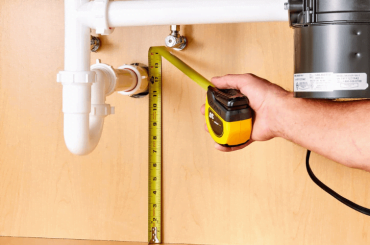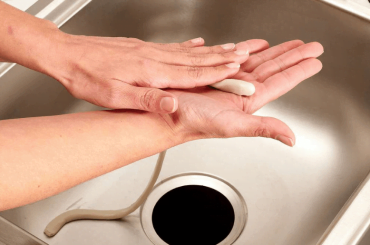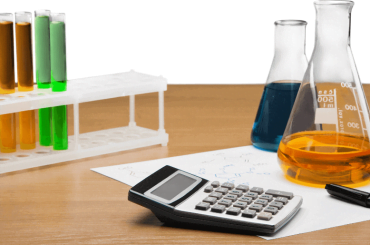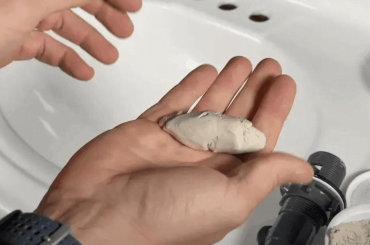The disposal is one of the most important appliances in your kitchen and it’s important to keep it clean so that it can function properly. While most people know that they should use dish soap to clean their dishwashers, many aren’t sure if they should use ice to clean their garbage disposal.
In this blog post, we’ll look at whether ice cubes are an effective way to clean a garbage disposal and share some tips on how to properly clean your disposal. Stay tuned!
Clean Garbage Disposal With Ice
Ice cubes can help break down any hardened food particles or grease that may be stuck in the blades of your garbage disposal,
The sharp edges of the ice cubes scrape away any food or grime that has built up on the blades and in hard-to-reach areas.
Additionally, it’s believed that the cold temperature of the ice helps to reduce any odours coming from your disposal.
However, using ice cubes alone won’t be enough to effectively clean your garbage disposal — you also need to use a good cleaning solution as well. For best results, combine 1/4 cup of baking soda with 1/2 cup of vinegar and then pour it down the drain along with several cups of crushed ice.
Allow the mixture to sit for about 15 minutes before flushing it with cold water.
Overall, using ice cubes to clean your garbage disposal is an effective way to remove stubborn food particles or grime, but it shouldn’t be used as the sole method of cleaning.
Make sure to use a combination of ice cubes, dish soap and vinegar for the best results.
Finally, don’t forget to flush with cold water after you’ve finished cleaning your disposal.
Can ice clean a garbage disposal?
Yes, ice cubes can be used to help clean garbage disposal. Ice cubes are great at grinding up any food particles or debris that may have become stuck in the disposal blades and can help sharpen them as well.
To use ice cubes to clean your disposal, simply fill the sink halfway with cold water and add several handfuls of ice cubes. Turn on the disposal and let it run until all the ice has been processed.
This should dislodge any build-up and clear out any blockages inside the blades or pipes.
After running the ice through the disposal, flush it with hot tap water for a few seconds to remove any remaining pieces. Regularly cleaning your garbage disposal with ice will help ensure that it runs smoothly for years to come.
If the problem persists, you may need to call a professional plumber for further assistance. Remember, safety is key when dealing with garbage disposal. Be sure to always use caution and follow all manufacturer’s instructions for proper operation.
Also, never put your hand in the disposal – it can be dangerous! Always remember to unplug the disposal before attempting any repairs or maintenance.
By following these simple steps you can keep your garbage disposal clean and running smoothly.
How To Clean Garbage Disposal With Ice?
Fill the sink halfway with cold water. Put several handfuls of regular or crushed ice cubes into the garbage disposal. Turn on the chilly water and let it run down into the disposal while you turn on the garbage disposal.
The force of the ground should help break up any stuck-on food particles, while the coldness of the ice helps to dislodge them from surfaces within the unit. Run cold water through for a few minutes afterwards to flush away debris from inside your garbage disposal.
Finally, pour some white vinegar into your sink and allow it to sit for 15 minutes before running hot water for about 5 minutes.
This will sanitize and deodorize your machine. Enjoy a clean, fresh-smelling kitchen!
Additional tips for cleaning your garbage disposal
- For tough garbage disposal odours, try pouring 1/2 cup of baking soda down the drain followed by half a cup of white vinegar. Allow it to sit for 15 minutes, then rinse with hot water.
- Regularly grind up ice cubes and lemon peel to keep the blades sharp and reduce odours that have accumulated in the disposal unit.
- Make sure you run plenty of cold water while grinding food waste in the garbage disposal. This helps flush away any residue or particles stuck to the walls of your pipes or drainage system.
- To avoid clogging your pipes, pour cooking grease into a can and throw it in the trash instead of down your drain! Grease and oil can solidify and create a clog in your pipes.
- To reduce the amount of food waste accumulating in your garbage disposal, use it daily or weekly to grind up any leftover food that you have cooked with.
- If you have stubborn food particles stuck in your garbage disposal, try pouring boiling water down the drain to loosen it up. Be careful not to get burned!
- For regular maintenance, pour 1 cup of baking soda and 1 cup of white vinegar into the disposal unit and let it sit for 30 minutes before rinsing it with hot water. This helps break down some of the built-up grease and grime inside your garbage disposal.
- Finally, never put fibrous foods like celery, artichoke leaves, or banana peels down your garbage disposal. Such items can wrap around the blades and cause damage to your unit.
By following these simple tips you can ensure that your garbage disposal remains in good working order and continues to provide reliable service for years to come!
FAQs – Garbage Disposal Cleaning With Ice
How much ice do you need to clean a garbage disposal?
The amount of ice needed to clean garbage disposal varies depending on the size and depth of your sink. Generally, it is recommended to use at least one cup or two cups of ice for a standard-sized sink.
Is it OK to pour boiling water down a garbage disposal?
No, it is not recommended to pour boiling water down a garbage disposal. Boiling water can damage the internal components of the disposal, including the blades and motor, which can lead to more costly repairs.
Additionally, boiling water will not help clear out stubborn clogs. Instead, it is recommended to use a plunger or specialized drain cleaning solution.
Why should you never put down a garbage disposal?
It is important to never put down the garbage disposal for a couple of reasons.
First, it can cause serious damage if the blades are exposed. The blades beneath the sink can become extremely sharp and if something gets caught in them, it could cause injury or further damage to the disposal.
Second, garbage disposals can easily become clogged if not handled properly. Food particles that are too large or items that should not be put down disposal can accumulate and cause a blockage. This can lead to the disposal malfunctioning, requiring repairs and in some cases, even replacement.
Finally, putting objects down the disposal that are not meant to be there can damage the blades or motor. It is best to avoid putting anything down a garbage disposal that is not meant to be there, as the damage can be costly and inconvenient.
What is best to clean a garbage disposal?
The best way to clean garbage disposal is to first turn off the power. Once the power is off, use a combination of baking soda, white vinegar and hot water. Start by using a non-metal kitchen scrub brush to remove any food residue on the walls of your garbage disposal.
Next, make a solution of equal parts baking soda and white vinegar and pour it into the disposal. Wait for the fizzing to stop, then pour a pot of boiling water into the disposal. Turn the garbage disposal on for about a minute to flush the solution through it.
Finally, run cold water into the garbage disposal for a few minutes to rinse away any remaining baking soda and vinegar residue. Once this is done, turn the power back on and your garbage disposal should be running like new.
In summary
Although ice is a helpful tool for cleaning your garbage disposal, it’s not the only way to get the job done. If you don’t have any ice on hand there are other ways to clean your disposal that still involve using common household items.
So if you’re looking for an easy and affordable way to keep your disposal clean give one of these methods a try!





